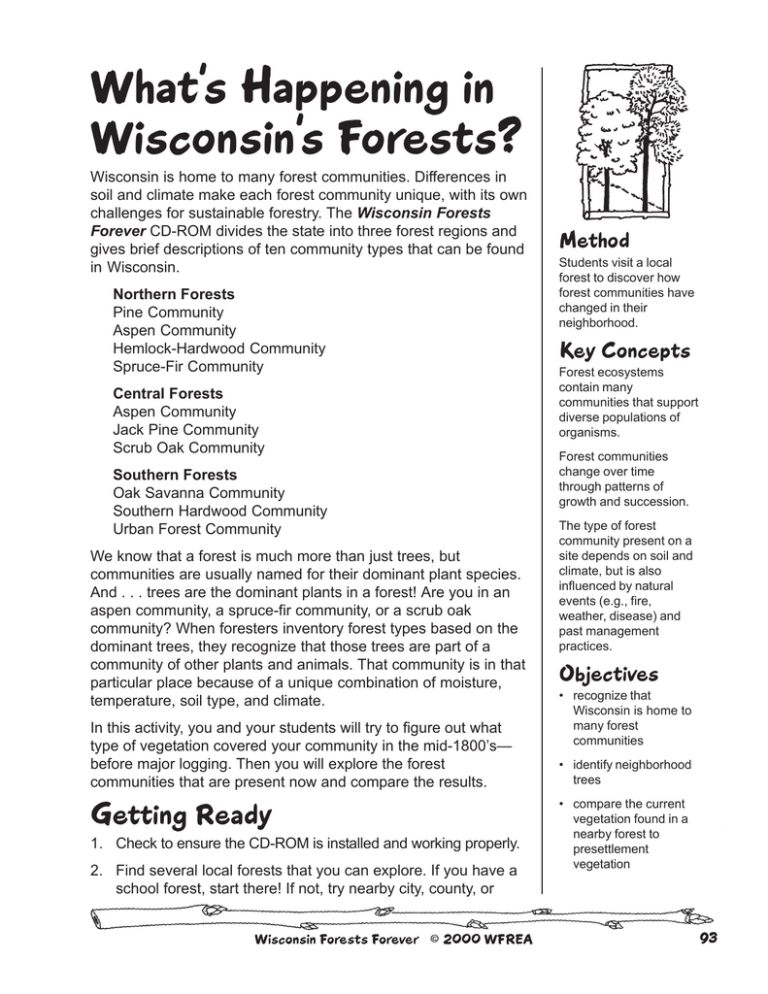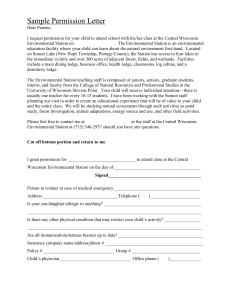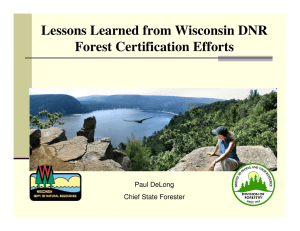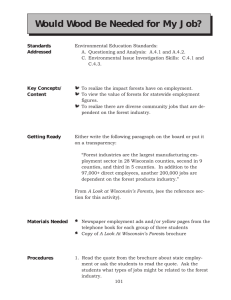What’s Happening in Wisconsin’s Forests?
advertisement

What’s Happening in Wisconsin’s Forests? Wisconsin is home to many forest communities. Differences in soil and climate make each forest community unique, with its own challenges for sustainable forestry. The Wisconsin Forests Forever CD-ROM divides the state into three forest regions and gives brief descriptions of ten community types that can be found in Wisconsin. Northern Forests Pine Community Aspen Community Hemlock-Hardwood Community Spruce-Fir Community Central Forests Aspen Community Jack Pine Community Scrub Oak Community Southern Forests Oak Savanna Community Southern Hardwood Community Urban Forest Community We know that a forest is much more than just trees, but communities are usually named for their dominant plant species. And . . . trees are the dominant plants in a forest! Are you in an aspen community, a spruce-fir community, or a scrub oak community? When foresters inventory forest types based on the dominant trees, they recognize that those trees are part of a community of other plants and animals. That community is in that particular place because of a unique combination of moisture, temperature, soil type, and climate. In this activity, you and your students will try to figure out what type of vegetation covered your community in the mid-1800’s— before major logging. Then you will explore the forest communities that are present now and compare the results. Getting Ready 1. Check to ensure the CD-ROM is installed and working properly. 2. Find several local forests that you can explore. If you have a school forest, start there! If not, try nearby city, county, or Wisconsin Forests Forever © 2000 WFREA Method Students visit a local forest to discover how forest communities have changed in their neighborhood. Key Concepts Forest ecosystems contain many communities that support diverse populations of organisms. Forest communities change over time through patterns of growth and succession. The type of forest community present on a site depends on soil and climate, but is also influenced by natural events (e.g., fire, weather, disease) and past management practices. Objectives • recognize that Wisconsin is home to many forest communities • identify neighborhood trees • compare the current vegetation found in a nearby forest to presettlement vegetation 93 Subjects & WI Academic Standards Science: A.4, B.4, C.4, E.4, F.4 A.8, B.8, C.8, F.8 Social Studies: A.4, A.8 English/ Language Arts: A.4, B.4, C.4, D.4, E.4, F.4 A.8, B.8, C.8, D.8, E.8, F.8 Materials • CD-ROM • maps showing precipitation and temperature differences around the state • map of presettlement vegetation of Wisconsin • aerial photos of your area of the state • Forest Trees of Wisconsin: How to Know Them • tree identification guides • a forester! • maps and/or photos of your location Preparation Time 30 minutes Activity Time 2 50-minute class periods and a field trip Setting classroom and outdoors state parks; state or county forests; public recreation areas; and/or state natural areas. See Finding Out More! for information on how to find nearby forest resources. 3. Gather several tree identification books and/or field guides. See the Appendix on page 113. Doing the Activity 1. Be sure that each student or small group of students has a chance to use the CD-ROM. They should go to the main menu and select the Balance section. They will be instructed to explore different regions of the state and discover how sustainable forestry works in each region. 2. Discuss the different forest communities around the state. Be sure students understand that different communities grow in different places based on local conditions. Look at Wisconsin maps that compare precipitation, summer and winter temperatures, and snowfall. Can you reach any conclusions? 3. Check out a map of the early vegetation in Wisconsin. See Finding Out More! for sources. What type of forest or community does the map suggest for your location? List the trees that would have been found in your area. 4. Invite a city, county, or state forester to visit your class and help with the project. 94 Ask whether he/she can bring maps, species lists, or early survey records that will help you identify what the local forests looked like. 5. Using tree identification books, such as the Forest Trees of Wisconsin: How to Know Them included in this kit, find pictures and descriptions of the trees that once grew near your school. 6. Visit a forest to inventory the trees, plants, and animals living there. Invite the forester to accompany you on the trip. His/her knowledge of the area will be invaluable! Use resource books and field guides to identify the trees in the area. Remember to look for the trees on the list you made. 7. Back in the classroom, compare your results. What did you find? What didn’t you find? How have the trees in your area changed? How have the changes affected the other plants and animals that live in the forest? How can you explain the similarities and differences? Wisconsin Forests Forever © 2000 WFREA 8. Obtain aerial photographs of forests in your area. If possible, also obtain photos from the mid1900’s. Students can compare these photos and talk about how and why the forests have changed over time. See Finding Out More! for photo sources. 9. Look back at the information your students collected in the activity “Timber! The History of Forestry in Wisconsin.” Review your local forest history. Was your area logged? Did fires burn here? Was the land ever farmed? Was it allowed to regenerate naturally or was it replanted? 10. Talk to your forester about how forests in your area are being managed. If the forest is radically different from presettlement times, is that OK? Can we or should we try to “re-create” the forests of the past? Is the forest you visited diverse? The CD-ROM pointed out unique challenges around the state. What are the issues that are inspiring or hampering sustainable forestry in your local community? Assessing Student Understanding Evaluate student participation in class discussion and field exploration. Assess their map reading and identification skills. Instruct students to write short stories describing the changes that have occurred in the forest they visited. Encourage them to write the story from an interesting perspective. One view could be that of an older person who grew up here 75 years ago and is now returning for the first time. Another could be that of a turtle that has lived on the land for the last 50 years. Extending Student Learning Identify Your Local Trees Identifying a tree is probably a new skill for your students. These activities will help you teach your students how to know trees: Z The NatureScope: Trees Are Terrific! activity “Keying Out Trees” uses a “people key” to help kids understand how an identification key works. “Twig Detectives” helps students recognize the parts of a twig. Grades 3 - 7. Z The Project Learning Tree activity “Name That Tree” introduces several identifying features of trees and reinforces the learning with a game. Grades 2 - 8. Wisconsin Forests Forever © 2000 WFREA 95 Z The Wisconsin’s Millennium Tree activity “Local Tree Identification Guide” helps students sort and classify local tree leaves. Grade 4. Discover Global Forest Types on the Web Temperate Forest Foundation. This website includes information about forest ecosystems around the globe. www.forestinfo.org Follow these links: DiscoverrCool FactsrForest Zones World Forest Institute. This website takes you to forests in many countries. www.vpm.com/wfi/resources.htm Create Leaf Art Do you have leftover leaves from your field trip? The book Look What I Did With a Leaf by Morteza E. Sohi is filled with creative ideas for turning leaves into animals, nature scenes, and even monsters. Finding Out More! Looking for a Field Trip Site? State Natural Areas. These parcels of land are great examples of natural communities. They are protected by the Department of Natural Resources and can be found all over the state. Visit the WDNR website to search for nearby state natural areas. www.dnr.state.wi.us Follow these links: Natural ResourcesrEndangered ResourcesrState Natural AreasrListed by County State Forests www.dnr.state.wi.us/org/land/forestry/StateForests County Forests www.wisconsincountyforests.com Industrial Forests www.wipapercouncil.org Recreational Opportunities on Federal Lands www.recreation.gov Wisconsin Wildlife Viewing Guide by Mary K. Judd. This guide covers many of the state parks, natural areas, sanctuaries, nature centers, and wildlife areas around the state. 96 Wisconsin Forests Forever © 2000 WFREA Wisconsin Department of Natural Resource’s Public Wildlife Recreation Land published by WDNR - Bureau of Wildlife Management. This booklet lists public lands that are open for people to hunt, fish, hike, canoe, and watch wildlife. Understanding the Public Land Survey System Wisconsin Department of Natural Resources www.dnr.state.wi.us./org/land/forestry/Private/PLSSTut/plsstut1.htm Locating Climate Maps National Weather Service View climatology reports for selected Wisconsin cities. www.crh.noaa.gov/mkx/climate.htm The Wisconsin Page www.uwsp.edu/acaddept/geog/wisconsin Wisconsin State Climatology Office www.uwex.edu/sco/state.html Locating Vegetation and Soil Maps Wisconsin Department of Natural Resources www.dnr.state.wi.us/org/at/et/geo/map_gal/landcov Wisconsin Geological and Natural History Survey www.uwex.edu/wgnhs Wisconsin State Cartographer’s Office http://feature.geography.wisc.edu/sco Locating Aerial Photos County Land Use Planning Departments. Contact the Land Information Officer for your county. Check the county government section of your local phonebook. Farm Service Agency. Purchase photos for your town, range, and section by calling the Farm Service Agency in your county. Look in the federal government section of your local phone book. Regional Planning Commissions. Find out about the Regional Planning Commission for your county by visiting the State of Wisconsin Information Server website and searching for Regional Planning Commissions. http://badger.state.wi.us/ Wisconsin’s Statewide Aerial Photography Project. Purchase photos from all over the state using an order form available from the Wisconsin Dept. of Natural Resources, Bureau of Forestry, P.O. Box 7921, Madison, WI 53707, (608) 264-8990. www.dnr.state.wi.us/org/land/forestry/airphoto/index.htm Wisconsin Forests Forever © 2000 WFREA 97 Obtaining Early Survey Notes State Historical Society of Wisconsin. Surveyors’ field notes are very interesting and reveal a lot about what your area looked like prior to European settlement. To obtain them, you must know the town, range, and section of the forest. Contact: SHSW, 816 State St., Madison, WI 53706, (608) 264-6400. www.shsw.wisc.edu/localhistory/articles/surveyor.htm Copies of the notes are also available through interlibrary loan. You can also try your county’s Register of Deeds or County Surveyor to see if copies are available locally. Finding Out About Wisconsin Forests Online eNature, Inc. This site is filled with online field guides! www.enature.com TreeLink. This site has an online tree key. www.treelink.org/whattree/ Wisconsin Department of Natural Resources. Find out the results of the latest inventory of Wisconsin’s forests. www.dnr.state.wi.us Follow these links: Natural ResourcesrForestryrA Look at Wisconsin’s Forests Wisconsin Department of Natural Resources. Try the tree key! www.dnr.state.wi.us/org/land/forestry Follow these links: A Look at Wisconsin ForestsrName that Tree Wisconsin’s Vascular Plants www.wisc.edu/herbarium 98 Wisconsin Forests Forever © 2000 WFREA



